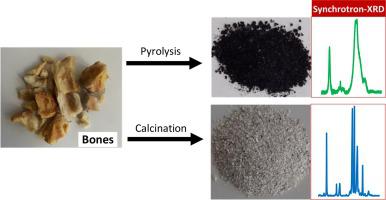Waste Management ( IF 8.1 ) Pub Date : 2021-06-24 , DOI: 10.1016/j.wasman.2021.06.012 Cristiano Dela Piccolla 1 , Dean Hesterberg 2 , Takashi Muraoka 3 , Etelvino Henrique Novotny 4

|
Selecting pyrolysis parameters for recycling P-rich and hazardous biowastes, such as bones, into fertilizers is still a challenge. Our objective was to improve pyrolysis procedures of pig bones for the production of P fertilizers. Bone chars were produced by pyrolysis at 400, 550, or 800 °C with no gas addition; 550 and 800 °C under N2; 800 °C under steam flux, using calcination at 800 °C as control treatment. Synchrotron-based X-ray diffraction and X-ray absorption near edge structure spectroscopy at the P and Ca K- and L-edges showed that these bone chars were largely composed of hydroxyapatite. Hydroxyapatite crystallization was inhibited by pyrolysis conducted in the absence of oxygen at 400, 550, or 800 °C, either under no gas or under N2 flux. The clogging of pores by lack of organic compounds removal was hypothesized to cause low surface area of 400 °C bone char, resulting in a fertilizer with citric-acid soluble P as low as calcination, while 550 and 800 °C bone chars obtained in absence of oxygen showed greater porosity, surface area, and citric acid-soluble P than steamed or calcined samples at 800 °C. Although extractable phosphate in water and neutral-ammonium-citrate showed trends comparable to those from citric acid, it was negligible for all heated materials. Since it is possible to produce bone chars with different chemical, physical and crystallographic properties by managing pyrolysis conditions, bone chars can be designed to increase their suitability as P fertilizers for different purposes, such as high solubility or slow P release.
中文翻译:

优化热解条件以回收猪骨制成磷肥
选择热解参数以将富含磷的有害生物废物(如骨头)回收到肥料中仍然是一个挑战。我们的目标是改进用于生产磷肥的猪骨的热解程序。骨炭是通过在 400、550 或 800 °C 下热解产生的,不添加气体;在 N 2下 550 和 800 °C ;800°C 蒸汽通量下,使用 800°C 煅烧作为控制处理。基于同步加速器的 X 射线衍射和 X 射线吸收近边结构光谱在 P 和 Ca K 和 L 边缘表明这些骨炭主要由羟基磷灰石组成。在 400、550 或 800 °C、无气体或 N 2条件下,在没有氧气的情况下进行热解会抑制羟基磷灰石结晶通量。假设缺乏有机化合物去除导致孔隙堵塞导致 400 °C 骨炭的表面积低,导致柠檬酸可溶性 P 低至煅烧的肥料,而 550 和 800 °C 的骨炭则在不存在的情况下获得在 800 °C 下,氧气的孔隙率、表面积和柠檬酸可溶性 P 比汽蒸或煅烧样品更大。尽管水中的可提取磷酸盐和中性柠檬酸铵显示出与柠檬酸相当的趋势,但对于所有加热材料而言,可忽略不计。由于可以通过控制热解条件生产具有不同化学、物理和晶体学特性的骨炭,因此可以设计骨炭以提高其作为磷肥的适用性,用于不同目的,例如高溶解度或缓慢的磷释放。


























 京公网安备 11010802027423号
京公网安备 11010802027423号